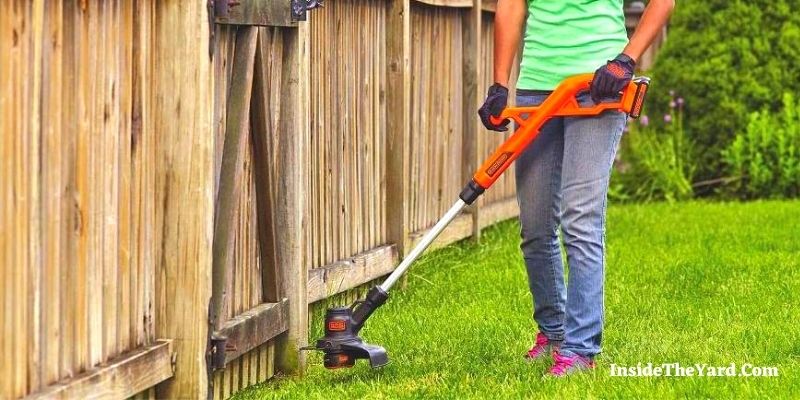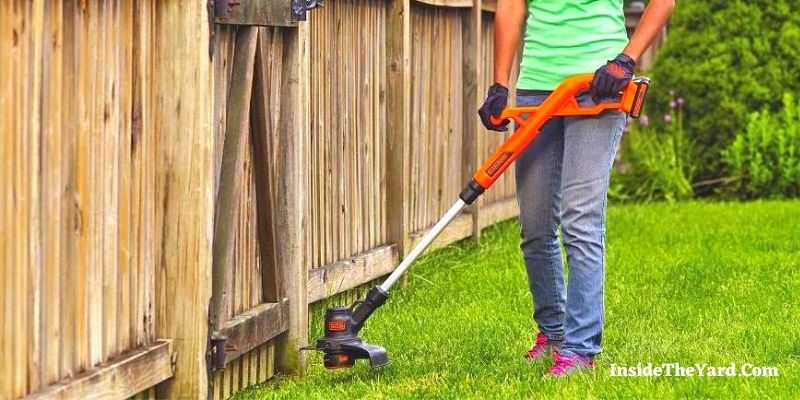
Weeds and unwanted plants grow abundantly in and around the fence line. Hence, we bring a weed eater to clear them off. But that makes us worried about how to protect my fence from weed eater as well.
To protect the fence while you get rid of weeds, you can pull the weeds out by hand. But that’s time-consuming. So, using a weed eater is necessary to keep the fence pristine.
But to keep the integrity of the fence, you can use post-protector products. Or you can DIY different ways to protect the base and fence posts of the fence.
Let’s find out how you can protect your fence while you use weed eaters.
How To Protect My Fence From Weed Eater
There are a couple of ways we can let you know through this guide. Check them out.
Fence Post Protection
Commercial products like 4X4 post protectors etc are available to protect the posts from mowing and trimming. Some products protect only one side of the post; others wrap the posts from all sides.
- First, remove debris and dust around the base of the post.
- Align the protector against the base.
- By using screws or nails, attach the fence protectors to the posts of the fence.
This will work as fence armor to prevent damage to wooden fences from weed eaters in the exposed lower areas of the fence.
But if you have a chain-link or iron fence, you don’t need fence post guards for protection from weed eaters. You only have to clear the weeds regularly.
Protection By Corrugated Piping
If you fit corrugated piping at the bottom of the fence, it will protect the fence from weed-eating hacks.
Corrugated pipes are thick, weather-proof, and crack resistant. They are built with the same materials that make regular drain pipes.
These pipes are better known as PVC pipes or Polyethylene Corrugated Tubing. You may have to cut on one end to cover the bottom ends by pushing them through. Though they are also available with a slit on one side. You may have to cut the pipes about 3-4 inches so that they are less visible.
These piping are also useful for covering the top end of the chainlink fences. This will prevent people from getting hurt by the sharp edges.
Decorative Protection
If spending a few bucks more won’t break your bank, you can protect your fence’s posts by placing ceramic tiles. You can also place tiles underneath the fence, on one or both sides.
This will prevent the growth of weeds or unwanted plants in and around the fence. And weed eaters can’t go near the fence. Also, you won’t have to go to close proximity to the fence for weeding. And as such, your fence will be safe from weed eaters.
The tiles won’t need to have a width of more than 6 inches. And instead of cementing them, you can just use construction adhesives to hold them to the ground.
And finally, paint them olive green or cobalt blue to mingle them with the lushness of your garden.
Protection Through Flashing
Thin metal is necessary when the roof is repaired or installed. This thin piece of metal is known as flashing, and you can use them as a fence post protector.
Just screw them over the posts. Or you can shield only the affected parts as well. Their shiny surfaces will reflect sunlight and remind you to be careful while you trim near the fence.
And, if the flashing seems a bit too much, just stick them in the ground along with the fence, when you weed. And when you are done weeding, remove them from the ground, roll them into a nice little role and leave them somewhere for future use.
Mind the Fence When You Weed
If we are careful and mind the fence while we weed, there will be a lot less damage to the fence. Angling the trimmer down towards the ground will keep the blades away from the posts or the fence.
Again, going at a slower pace will also save other structures and the plants we want to keep. A few models of lawnmowers have the technology of not giving the full throttle while you mow slowly.
Both of the above will also help the trimmer last longer.
And finally, using your own hands to weed the places around the fence may take a little longer. But surely will keep the fence intact.
Using Weedkiller Chemicals
Another effective way to remove weeds is to spray herbicides along the fence line. If you can arrange 2-3 treatments per year, you will have an excellent result in removing weeds.
So, you will have virtually no need to bring the weed eater near to the fence. Which, in turn, leaves the fence free from damage.
This Video Will Help You Too!
Frequently Asked Questions (FAQs)
How do you protect a PVC fence?
PVC fence is susceptible to weed eaters. To protect them from damage, you can use a fence post guard around the bottom of the post. Piping a,d decorative protection by ceramic tiles can also prevent damage to a PVC fence.
What can I use to block the bottom of my fence?
Wood, vinyl, or iron fences usually can block the bottom spaces. But if it’s a chainlink fence, the bottom is usually exposed. To block the bottom, I can use old tires, cinder blocks, chainlink fence skates, another decorative garden fence, a planter box just in front, etc. to block the bottom of my fence.
How do you mulch around a fence?
To mulch around a fence, first, remove the weeds from both sides. About a foot on both sides will do just fine. Then place the weed-blocker or the landscape fabric and hold them down by rocks every 3-7 feet. Now you can mulch around the fence. Just remember to use enough mulches to cover the fabric by 2-4 inches deep.
Will a weed eater damage a vinyl fence?
A weed eater will most certainly damage a vinyl fence. A vinyl fence essentially is made from various elements of plastic. They are no match for steel blades.
Final Thoughts
When I know how to protect my fence from weed eater, it can indeed save the fence from decaying fast.
Keeping the fence intact will also add to the aesthetic look of our garden. A fence free from weeds and unwanted plants will also save the garden from getting covered with plants that we never want in the first place.
However, the simple processes we have mentioned above can help you keep the fence nice and strong. And please don’t forget that, like the weed eater, the fence can also bite back and damage the machinery.
And that can end up bringing you more expenses.
You Can Also Read:
- How to Bid Trimming Bushes? Know the Right Charge
- How To Replace RedMax Trimmer Head Easily?
- How to Remove Dead Grass After Roundup- 4 Easy Way
- How Many Ohms Should a PTO Clutch Have? The Best Idea for you
- How to Remove Plastic Landscape Edging- Learn All the Techniques In Details
Was it helpful?

Enamored with the world of golf Jack pursued a degree in Golf Course Management at THE Ohio State University. This career path allowed him to work on some of the highest profile golf courses in the country! Due to the pandemic, Jack began Inside The Yard as a side hustle that quickly became his main hustle. Since starting the company, Jack has relocated to a homestead in Central Arkansas where he and his wife raise cattle and two little girls.

